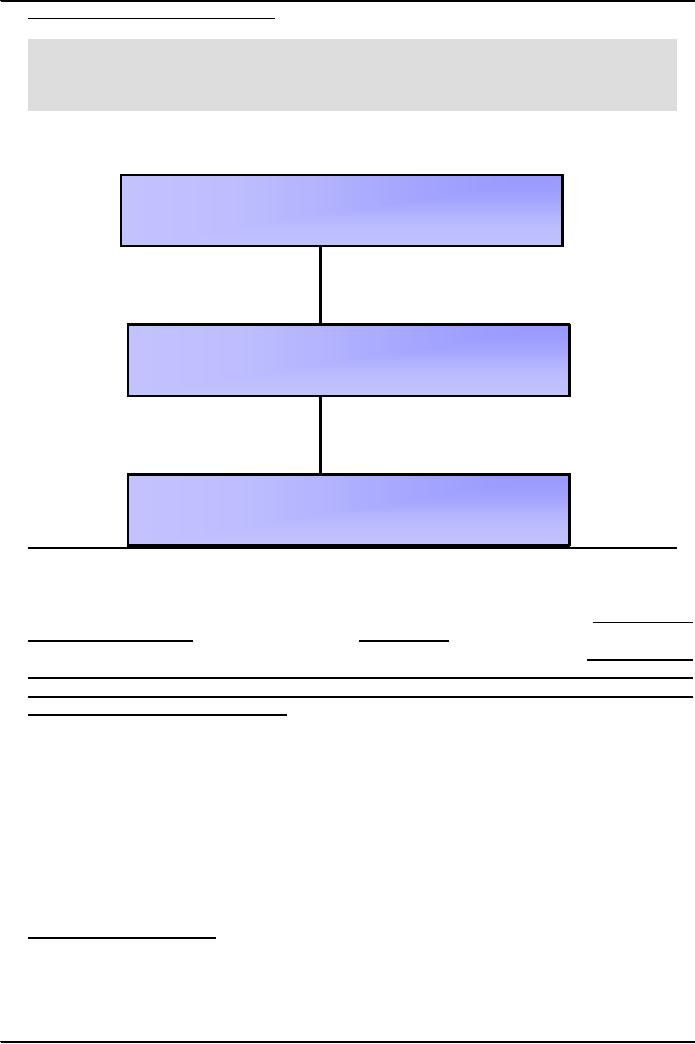 |

Strategic
Management MGT603
VU
Michael
Porter's Generic
Strategies
Michael Porter's
Generic Strategies
Cost
Leadership Strategies
Differentiation
Strategies
Focus
Strategies
Probably
the three most widely read
books on competitive analysis in the
1980s were Michael
Porter's
Competitive
Strategy,
Competitive
Advantage and
Competitive
Advantage of Nations.
According to Porter,
strategies
allow organizations to gain
competitive advantage from
three different bases: cost
leadership,
differentiation,
and focus. Porter calls
these bases generic
strategies. Cost leadership
emphasizes
producing
standardized
products at very low per-unit cost
for consumers who are
price-sensitive. Differentiation
is
a
strategy
aimed at producing products and
services considered unique industry wide
and directed at
consumers
who are relatively price-insensitive.
Focus
means
producing products and services
that fulfill
the
needs of small groups of
consumers.
Porter's
strategies imply different organizational
arrangements, control procedures,
and incentive
systems.
Larger firms with greater
access to resources typically
compete on a cost leadership
and/or
differentiation
basis, whereas smaller firms
often compete on a focus
basis.
Porter
stresses the need for
strategists to perform cost-benefit
analyses to evaluate "sharing
opportunities"
among a firm's existing and potential
business units. Sharing activities and
resources
enhances
competitive advantage by lowering
costs or raising differentiation. In
addition to prompting
sharing,
Porter stresses the need for firms to
"transfer" skills and
expertise among autonomous
business
units
effectively in order to gain
competitive advantage. Depending
upon factors such as type
of
industry,
size of firm, and nature of
competition, various strategies could
yield advantages in
cost
leadership,
differentiation, and
focus.
Cost
Leadership Strategies
This
strategy emphasizes efficiency. By
producing high volumes of
standardized products, the
firm
hopes
to take advantage of economies of
scale and experience curve
effects. The product is
often a
basic
no-frills product that is produced at a
relatively low cost and made
available to a very large
customer
base. Maintaining this strategy
requires a continuous search for
cost reductions in all
aspects
85

Strategic
Management MGT603
VU
of
the business. The associated
distribution strategy is to obtain the
most extensive
distribution
possible.
Promotional strategy often
involves trying to make a
virtue out of low cost
product features.
To
be successful, this strategy usually
requires a considerable market
share advantage or preferential
access
to raw materials, components,
labour, or some other
important input. Without one
or more of
these
advantages, the strategy can
easily be mimicked by competitors. Successful
implementation also
benefits
from:
Process
engineering skills
Products
designed for ease of
manufacture
Sustained
access to inexpensive
capital
Close
supervision of labour
Tight
cost control
Incentives
based on quantitative
targets
Market
of many price-sensitive
buyers
Few
ways of achieving product
differentiation
Buyers
not sensitive to brand
differences
Large
number of buyers with bargaining
power
Pursued
in conjunction with
differentiation
Economies
or diseconomies of scale
Capacity
utilization achieved
Linkages
with suppliers and
distributors
A
primary reason for pursuing forward,
backward, and horizontal
integration strategies is to gain
cost
leadership
benefits. But cost
leadership generally must be
pursued in conjunction with
differentiation. A
number
of cost elements affect the relative
attractiveness of generic strategies,
including economies or
diseconomies
of scale achieved, learning and
experience curve effects, the
percentage of capacity
utilization
achieved, and linkages with
suppliers and distributors. Other
cost elements to consider
in
choosing
among alternative strategies include the
potential for sharing costs
and knowledge within the
organization,
R&D costs associated with
new product development or modification
of existing
products,
labor costs, tax rates,
energy costs, and shipping
costs.
Striving
to be the low-cost producer in an industry can be
especially effective when the market
is
composed
of many price-sensitive buyers, when
there are few ways to
achieve product
differentiation,
when
buyers do not care much
about differences from brand to brand, or
when there are a
large
number
of buyers with significant bargaining
power. The basic idea is to
under price competitors and
thereby
gains market share and
sales, driving some competitors
out of the market
entirely.
A
successful cost leadership
strategy usually permeates the entire
firm, as evidenced by high
efficiency,
low
overhead, limited perks, intolerance of
waste, intensive screening of budget
requests, wide spans of
control,
rewards linked to cost containment,
and broad employee participation in
cost control efforts.
Some
risks of pursuing cost leadership
are that competitors may imitate the
strategy, thus
driving
overall
industry profits down; technological breakthroughs in
the industry may make the
strategy
ineffective;
or buyer interest may swing to
other differentiating features
besides price. Several
example
firms
that are well known
for their low-cost leadership
strategies are Wal-Mart,
BIC, McDonald's,
Black
and
Decker, Lincoln Electric, and Briggs
and Stratton.
Low
Cost Producer
Advantages
The
first point depends upon the
condition of the price fluctuation in the
market; this can also
be
understood
with the help of elasticity of
demand. In any market, the
demand is sensitive to price this
is
called
price sensitivity of demand.
For
example, if price of any
commodity increases, the customer
carry on to buy the things. It
means
these
customers neither are price
sensitive. Other is the case
where customers move towards
the
alternates
with an increase in
demand.
The
second is the case where
there are few ways of
achieving product differentiation either
by changing
features,
price, cost or quality of the
product.
86

Strategic
Management MGT603
VU
Where
there are high end
products, there are the
customers who are brand
sensitive, because, people
want
to express their choices or personality
through that brand.
In
Bargaining power, low price
products have more
customers, more suppliers
and more bargaining
but
high
priced products there are low bargaining
power due to the fewer
customers.
Differentiation
Strategies:
Differentiation
involves creating a product
that is perceived as unique. The unique
features or benefits
should
provide superior value for the
customer if this strategy is to be
successful. Because
customers
see
the product as unrivaled and
unequaled, the price elasticity of
demand tends to be reduced
and
customers
tend to be more brands loyal. This
can provide considerable
insulation from
competition.
However
there are usually additional
costs associated with the
differentiating product features
and this
could
require a premium pricing
strategy.
To
maintain this strategy the firm should
have:
Strong
research and development
skills
Strong
product engineering
skills
Strong
creativity skills
Good
cooperation with distribution
channels
Strong
marketing skills
Incentives
based largely on subjective
measures
Be
able to communicate the importance of the
differentiating product
characteristics
Stress
continuous improvement and
innovation
Attract
highly skilled, creative people
Greater
product flexibility
Greater
compatibility
Lower
costs
Improved
service
Greater
convenience
More
features
Differentiation
strategies Allow firm to charge
higher price gain customer
loyalty
In
the differentiation focus strategy, a
business aims to differentiate
within just one or a small
number
of
target market segments. The
special customer needs of the
segment means that there
are
opportunities
to provide products that are
clearly different from competitors
who may be targeting a
broader
group of customers. The
important issue for any
business adopting this strategy is to
ensure
that
customers really do have
different needs and wants -
in other words that there is
a valid
basis for
differentiation
- and
that existing competitor products are
not meeting those needs
and wants.
Focus
Strategy - Cost
Focus
In
this strategy the firm concentrates on a
select few target markets. It is
also called a focus strategy
or
niche
strategy. It is hoped that by focusing
your marketing efforts on one or
two narrow market
segments
and tailoring your marketing
mix to these specialized
markets, you can better meet
the needs
of
that target market. The
firm typically looks to gain a
competitive advantage through
effectiveness
rather
than efficiency. It is most suitable
for relatively small firms but
can be used by any company.
As a
focus
strategy it may be used to
select targets that are
less vulnerable to substitutes or where
a
competition
is weakest to earn above-average
return on investments.
Industry
segment of sufficient
size
Good
growth potential
Not
crucial to success of major
competitors
Consumers
have distinctive
preferences
Rival
firms not attempting to specialize in the
same target segment
Here
a business seeks a lower-cost
advantage in just on or a small number of
market segments. The
product
will be basic - perhaps a
similar product to the higher-priced and
featured market leader,
but
acceptable
to sufficient consumers. Such
products are often called
"me-too's".
87

Strategic
Management MGT603
VU
Niche
strategies
Here
the organization focuses its effort on
one particular segment and
becomes well known
for
providing
products/services within the segment.
They form a competitive
advantage for this
niche
market
and either succeeds by being a low
cost producer or differentiator within
that particular
segment.
Recent
developments
Michael
Treacy and Fred Wiersema
(1993) have modified
Porter's three strategies to
describe three
basic
"value disciplines" that can
create customer value and
provide a competitive advantage.
They are
operational
excellence, product innovation,
and customer intimacy.
Criticisms
of generic strategies
Several
commentators have questioned the
use of generic strategies claiming they
lack specificity, lack
flexibility,
and are limiting. In many
cases trying to apply generic
strategies is like trying to
fit a round
peg
into one of three square
holes: You might get the
peg into one of the holes,
but it will not be a
good
fit.
In
particular, Millar (1992) questions the
notion of being "caught in the middle". He
claims that there is
a
viable middle ground between
strategies. Many companies,
for example, have entered a
market as a
niche
player and gradually
expanded. According to Baden-Fuller and
Stop ford (1992) the
most
successful
companies are the ones that
can resolve what they call
"the dilemma of opposites".
88
Table of Contents:
- NATURE OF STRATEGIC MANAGEMENT:Interpretation, Strategy evaluation
- KEY TERMS IN STRATEGIC MANAGEMENT:Adapting to change, Mission Statements
- INTERNAL FACTORS & LONG TERM GOALS:Strategies, Annual Objectives
- BENEFITS OF STRATEGIC MANAGEMENT:Non- financial Benefits, Nature of global competition
- COMPREHENSIVE STRATEGIC MODEL:Mission statement, Narrow Mission:
- CHARACTERISTICS OF A MISSION STATEMENT:A Declaration of Attitude
- EXTERNAL ASSESSMENT:The Nature of an External Audit, Economic Forces
- KEY EXTERNAL FACTORS:Economic Forces, Trends for the 2000’s USA
- EXTERNAL ASSESSMENT (KEY EXTERNAL FACTORS):Political, Governmental, and Legal Forces
- TECHNOLOGICAL FORCES:Technology-based issues
- INDUSTRY ANALYSIS:Global challenge, The Competitive Profile Matrix (CPM)
- IFE MATRIX:The Internal Factor Evaluation (IFE) Matrix, Internal Audit
- FUNCTIONS OF MANAGEMENT:Planning, Organizing, Motivating, Staffing
- FUNCTIONS OF MANAGEMENT:Customer Analysis, Product and Service Planning, Pricing
- INTERNAL ASSESSMENT (FINANCE/ACCOUNTING):Basic Types of Financial Ratios
- ANALYTICAL TOOLS:Research and Development, The functional support role
- THE INTERNAL FACTOR EVALUATION (IFE) MATRIX:Explanation
- TYPES OF STRATEGIES:The Nature of Long-Term Objectives, Integration Strategies
- TYPES OF STRATEGIES:Horizontal Integration, Michael Porter’s Generic Strategies
- TYPES OF STRATEGIES:Intensive Strategies, Market Development, Product Development
- TYPES OF STRATEGIES:Diversification Strategies, Conglomerate Diversification
- TYPES OF STRATEGIES:Guidelines for Divestiture, Guidelines for Liquidation
- STRATEGY-FORMULATION FRAMEWORK:A Comprehensive Strategy-Formulation Framework
- THREATS-OPPORTUNITIES-WEAKNESSES-STRENGTHS (TOWS) MATRIX:WT Strategies
- THE STRATEGIC POSITION AND ACTION EVALUATION (SPACE) MATRIX
- THE STRATEGIC POSITION AND ACTION EVALUATION (SPACE) MATRIX
- BOSTON CONSULTING GROUP (BCG) MATRIX:Cash cows, Question marks
- BOSTON CONSULTING GROUP (BCG) MATRIX:Steps for the development of IE matrix
- GRAND STRATEGY MATRIX:RAPID MARKET GROWTH, SLOW MARKET GROWTH
- GRAND STRATEGY MATRIX:Preparation of matrix, Key External Factors
- THE NATURE OF STRATEGY IMPLEMENTATION:Management Perspectives, The SMART criteria
- RESOURCE ALLOCATION
- ORGANIZATIONAL STRUCTURE:Divisional Structure, The Matrix Structure
- RESTRUCTURING:Characteristics, Results, Reengineering
- PRODUCTION/OPERATIONS CONCERNS WHEN IMPLEMENTING STRATEGIES:Philosophy
- MARKET SEGMENTATION:Demographic Segmentation, Behavioralistic Segmentation
- MARKET SEGMENTATION:Product Decisions, Distribution (Place) Decisions, Product Positioning
- FINANCE/ACCOUNTING ISSUES:DEBIT, USES OF PRO FORMA STATEMENTS
- RESEARCH AND DEVELOPMENT ISSUES
- STRATEGY REVIEW, EVALUATION AND CONTROL:Evaluation, The threat of new entrants
- PORTER SUPPLY CHAIN MODEL:The activities of the Value Chain, Support activities
- STRATEGY EVALUATION:Consistency, The process of evaluating Strategies
- REVIEWING BASES OF STRATEGY:Measuring Organizational Performance
- MEASURING ORGANIZATIONAL PERFORMANCE
- CHARACTERISTICS OF AN EFFECTIVE EVALUATION SYSTEM:Contingency Planning